Behind the bar: Why it helps to be a little obsessive if you’re a bartender

- Share via
When you own a bar, everywhere you look you see withered garnishes, sputtering votive candles and napkins shredded by a nervous guest. The lights are too dim. The music is too loud. A faucet drips. Fossilized lipstick congeals on the rim of a freshly poured daiquiri. A glass shatters. Ten seconds go by and no one races to clean it up. Your security guard is glued to his cellphone as guests slip in through the door.
In the real world, people say you’re compulsive; it’s likely the reason you’re still single. But in the bar world, the disorder has another name. It’s called “systems and order,” and it forms a unified survival code. The code ensures that your cocktails contain precisely 2 ounces of booze, that your Old Fashioneds are chilled by a single big block of ice instead of many melty cubes, and that when there is still no table for the sweet couple who have waited patiently for 35 minutes, everyone knows to offer apologies and a round on the house.
These systems and order are a version of what is sometimes known as “knolling.” The idea of knolling began in 1987, when Frank Gehry’s studio janitor, Andrew Kromelow, would sweep the floors and empty the trash bins — Gehry was designing furniture for Florence Knoll at the time. After he’d finished cleaning, Kromelow would organize the designer’s haphazardly placed tools and writing implements, placing them at 90-degree angles to one another, in groupings relevant to their use.
The next time you’re at someone’s house, look around to see if the decorative platters might be parallel to the angle of the tiles on the kitchen’s backsplash.
This activity became known as “knolling.” In bars and restaurants, the only way to survive is to imbue your employees with a sort of OCD. Though some are born with a compulsion for order, others need to be taught. Before opening our first bar, we sought a way to illustrate this and stumbled upon “Working to Code,” a series of videos designed for members of the artist Tom Sachs’ studio team.
At the bar, knolling means that we set tins from left to right and reset our tools after we finished a round. It means that we lay a guest’s bar napkin in front of them without crossing our hand across their face, then placing the glass dead center of that napkin. Place drink garnishes at 2 p.m., assuming the rim of the glass is the dial of a clock. Serve drinks clockwise when delivering them to a table. Always set bottles down with the label facing out.
The next time you’re at someone’s house, look around to see if the decorative platters might be parallel to the angle of the tiles on the kitchen’s backsplash. If the books on the shelves are arranged from largest to smallest, from black to white to color. If the pictures on the walls are perfectly level. If so, odds are pretty good that your hosts run a bar. Either that, or they’re a little nuts.
A glass bottle smashes in the trash. You spin around and menacingly approach the bar. Someone once asked you what your toast would be on the way through the pearly gates. “Thanks for the memories,” you told them, “and when you finish that Champagne bottle, please place it gently in the bin.”
Eric Alperin owns and operates bars in downtown Los Angeles and Austin, Texas. Deborah Stoll is a journalist, novelist, animator and former bartender.
More to Read
Eat your way across L.A.
Get our weekly Tasting Notes newsletter for reviews, news and more.
You may occasionally receive promotional content from the Los Angeles Times.










